This article was published in Scientific American’s former blog network and reflects the views of the author, not necessarily those of Scientific American
Recently I realized that after a year of research at Sikundur, I haven’t properly introduced the real stars of our site – the orangutans themselves! Spending all-day following these amazing animals from nest to nest; recording their behavior, watching them grow, and trying to understand their social structure is utterly fascinating, so I think it’s only fair that I share a little bit about each of the individuals I’ve been fortunate enough to encounter. In this first blog I’m going to cover the females and their infants:
.jpg?w=400)
Credit: James Askew
Suci (20-25 years old) and Siboy (3-4 years old)
On supporting science journalism
If you're enjoying this article, consider supporting our award-winning journalism by subscribing. By purchasing a subscription you are helping to ensure the future of impactful stories about the discoveries and ideas shaping our world today.
First Encountered: 1/9/2012
Suci is the most frequently followed orangutan in our population because her home range is close to camp (we find her most often), and she’s the best habituated (we don’t lose her). Still being occasionally carried is her extremely playful infant, Siboy, who loves coming to look at researchers and messing around with the other infant orangutans!
Despite Siboy being too young for her to conceive again, we almost always find Suci being followed by Bendot Kecil, one of the site’s unflanged males. Every though copulation will not result in conception, he often tries to mate with her. For her part, Suci doesn’t resist, since she can’t get pregnant, and could get hurt. However, she certainly doesn’t encourage him either, as she would towards a “preferred” male, when she begins cycling once again.
These two are probably the most beloved individuals in our population; certainly Suci is my favourite orangutan, as a result, we were sad to see some mysterious injuries that appeared on Suci’s back in the middle of last year. We’re still not a hundred percent sure what happened though our theories include air rifle pellets, infected bite wounds, fungi and even toxic tree sap! Since these are wild animals, we couldn’t do anything about the injuries, we just had to wait. Fortunately, Suci is much better now, and we’re all looking forward to following her and Siboy over the next few years!
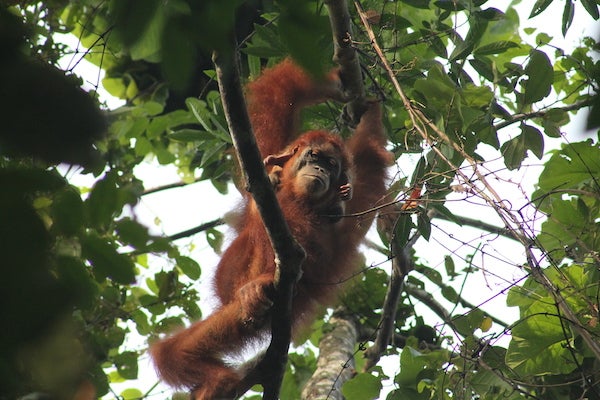
Credit: James Askew
Madelena (15-20 years old) & Malala (1 year old):
First Enountered: 9/9/2012 & 11/6/2014
Malala (aka Milala or Mala – bit of difficulty when it comes to naming orangutans as rival “factions” will write their own preference on the data sheets!) is the newest orangutan in our population, and the first infant to be born since SOCP’s behavioral monitoring started in 2013! This makes her the most critical animal for our understanding of this population since we’ll be able to monitor her throughout the course of her life, and get an idea of how orangutan life history is different in the low productivity habitat found at Sikundur. As a result we were all extremely excited when we saw her pale body draped around Madelena’s neck last July.
Madelena seems to be a wonderful mother, a skill that varies hugely amongst great apes, and which will give Malala a great head start for the future. As a direct result of this great parenting the little ape has grown quickly, is now very curious about the world, and already enjoys playing with much bigger infants (even if mum has to come and rescue her sometimes!).
Madelena is also one of our most followed individuals, again because her “home range” being close to camp. As with Suci, this allows us to collect high quality “natural” data without her kiss squeaking, running, throwing branches, and generally making a researcher life a misery! Again, she’s one of the site’s most popular animals, and we can’t wait to see little Malala grow up.
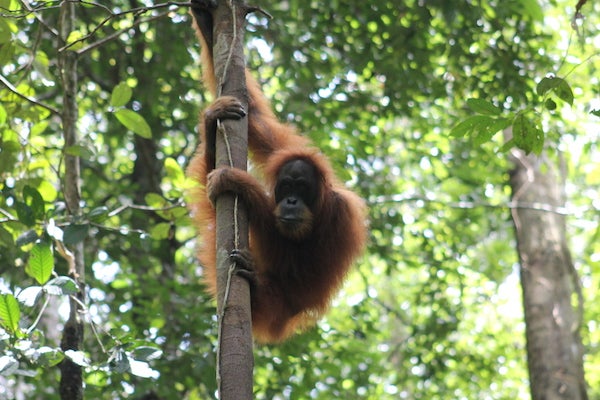
Credit: James Askew
Irma (25-30 years old) & Irfan (6-7 years old, not pictured)
First Encountered: 23/10/2013
Unfortunately for us, Irma does not like being followed; unleashing large numbers of kiss squeaks, and travelling larges distances until we inevitably have to abandon the follow outside the trail system. In part, we think this is because her infant Irfan is big enough to keep up, making an orangutans first strategy to lose a human follower – running in a straight line – an extremely effective one!
Irfan is the oldest of our infants, and will soon be off on his own; though perhaps this srill might take a little while, since male orangutans tend to be “mummy’s boys,” going off on their own later than female infants. This means his mother, Irma, is an interesting individual for us, since she should soon start to cycle in readiness for conceiving another infant, and we want to see who she picks to be the father!
Typically, while female infants will develop a home range adjacent to their mother, males are the dispersing sex and will travel far from their birthplace, so, once his new brother or sister is born, it’ll be interesting to see how often Irfan comes back over the next few years, and, if he moves into the OIC reforestation site to the North of Sikundur.
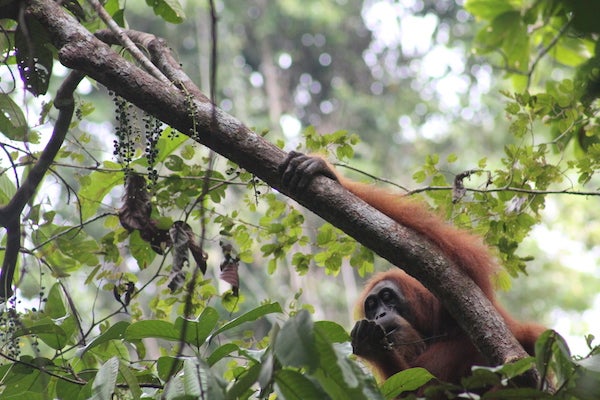
Credit: James Askew
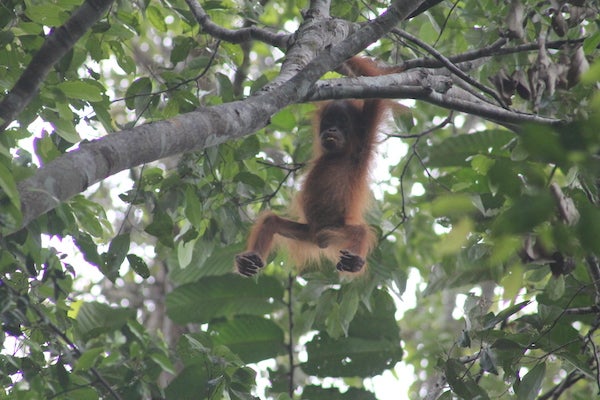
Credit: James Askew
Yanti (15-20 years old, top) & Yeni (3-4 years old)
First Encountered: 6/9/2012
Yanti is another individual who doesn’t particularly care for being followed, and often throws all manner of objects towards observers, once again kiss-squeaking for minutes on end. Her infant Yeni, is also more shy than the other infants, perhaps due to her mother’s dislike of humans, though she also doesn’t play with other infants very often, potentially indicating a generally less bold personality type. We rarely see these two orangutans, and when we do it’s always a challenge to keep following them, as they’ll use every possible trick to lose us, most often at the Western edge of the site where things start to get hilly and the secondary forest gets dense and prickly!
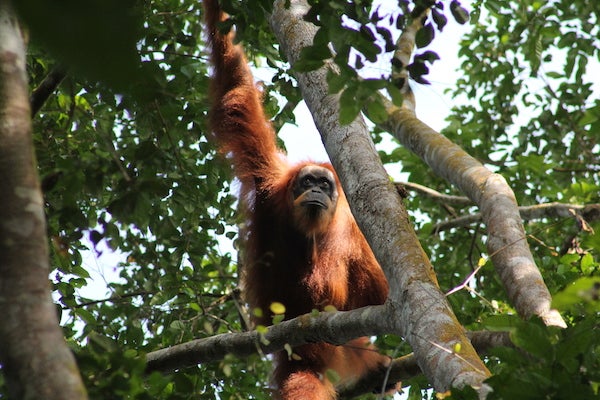
Credit: James Askew
Rakel (10-20 years old)
First Encountered: 9/11/2014
Rakel (aka Raquel) is the newest female orangutan we have encountered, and our only lone female at the site. Our first thought is that she’s nulliparous (yet to have her first infant), since female orangutans normally always have an infant, and she’s not pregnant. However, she is also quite a large orangutan, looking to be well over the age and size Sumatran orangutans normally reproduce for the first time (around the same as Suci, and bigger than Madeline). Indeed she did one one occasion produce a long distance vocalization of her own, perhaps advertizing her availability to mate
Despite this, Raquel’s interactions with males have been mostly ambivalent over this past year. Flanged males, especially Ompung, would travel with her, but she never allows them to come particularly close, producing “glottal” sounds that seemed to function to maintain distance. This could be her expressing her mate choice since previous studies have shown cycling females to pro-actively mate with the most “dominant” individual, while avoiding subordinates.
However, on a recent follow with a new male orangutan at the site, John, we found strong evidence for her cycling, as he repeatedly attempted to force copulations. Despite being much smaller, she fought back aggressively, biting, screaming incredibly loudly, and even falling out of the trees on two occasions as she attempted to evade the large male. Eventually, she found an escape route, climbing below the riverbank where the flanged male couldn’t follow. They could have stayed in this position for hours, but another male, perhaps hearing Rakel’s screams, began long calling from close by, and John went to chase him off.
Next up will be a blog all about the males at our site.